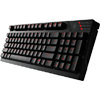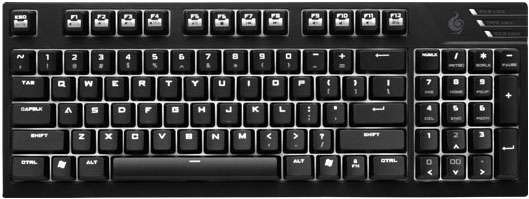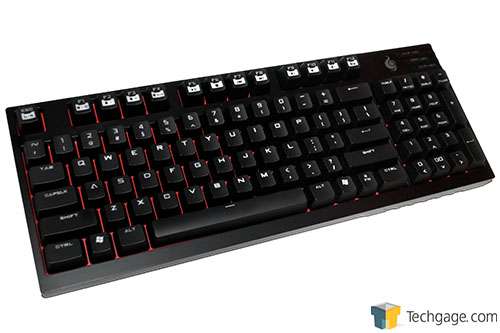- Qualcomm Launches Snapdragon 4 Gen 2 Mobile Platform
- AMD Launches Ryzen PRO 7000 Series Mobile & Desktop Platform
- Intel Launches Sleek Single-Slot Arc Pro A60 Workstation Graphics Card
- NVIDIA Announces Latest Ada Lovelace Additions: GeForce RTX 4060 Ti & RTX 4060
- Maxon Redshift With AMD Radeon GPU Rendering Support Now Available
CM Storm QuickFire TK Mechanical Gaming Keyboard Review

Through its Storm product line, Cooler Master has introduced an entire family of gaming-oriented peripherals. Time to add one more member to the mechanical keyboard lineup: the QuickFire TK. Featuring a unique layout and a compact footprint, how well does the TK measure up to its heralded sisters? Read on to find out.
Page 2 – Testing and Final Thoughts
Here at Techgage, when we test things like keyboards, mice, headsets and the like, we prefer to take our time with the review sample. There’s a simple reason for this: testing certain types of hardware – things like motherboards, CPUs, graphics cards, even cooling equipment – is more objective and relies on gathering empirical data, while testing peripherals is far more subjective. It’s all about the individual user’s experience.
I say this at the outset because some of what I’ll be describing in this phase of the review might inevitably be colored by my own personal experiences and biases. I’ve already noted in a previous keyboard review (GIGABYTE Osmium) that I have developed a preference for Cherry MX Blues; in the spirit of full disclosure, had I made the request in time, there’s an excellent chance that Techgage might have received a TK equipped with the MX Blues.
The reality is, though, we have the Cherry MX Red variant. So all the observations and descriptions here apply specifically to the review sample we have. And that includes my performance on typing tests with it.
Having said all this, though, there are objective aspects to reviewing a piece of hardware. With a keyboard, its layout is as good a place to start as any.

As we said earlier in this review, the CM Storm QuickFire TK has a unique form factor. I’ve never ever seen, much less used, a keyboard that has a numpad but not the cursor navigation key cluster (including the four arrow keys) prior to receiving the TK for review. I use the number pad a lot, both at my job and when at home; I also use the navigation keys too, particularly when working on writing projects as well as when browsing the Web. So clearly I’m one of those users who needs a keyboard with the full complement of keys.
The TK’s layout definitely takes some getting used to. When entering numbers, I mostly rely on the numpad, and on most keyboards my hand just finds it with my fingers in perfect position to enter numbers even without glancing down. On the TK, though, sometimes my hand placement is imprecise; instead of landing on 4-5-6, my fingers would be skewed to the right. This is a function of muscle memory, though; it’s impossible to unlearn years of technique after just a couple of weeks of using a new piece of equipment.
The decision to eschew distinct keys for the navigational key cluster results in a more compact physical layout, but it also means that you have to adapt to your hardware if you rely on these functions. On the TK, you can restore the navigational cluster by activating the Fn key, then turning off the Numlock key. This activates the arrow keys (which helpfully show up backlit) as well as the navigational keys. Unfortunately, the rest of the navigational keys (Ins, Del, Home, End, PgUp, and PgDn) do not activate their backlighting in this mode, so unless you’ve committed their positions to memory you will need to look down at the number pad and hit the correct keys. (For the record, they are: 7 = Ins; 4 = Del; 8 = Home; 5 = End; 9 = PgUp; and 6 = PgDn).
The trade-off, of course, is that you lose the use of the number pad because Numlock is deactivated. Not only that, you’re also sacrificing data entry speed since 1) it’s a two-step process (involving a 3sec lapse to allow the Fn key to toggle on) to restore these functions, and 2) you’re taking your eyes off of your copy and diverting them to the keyboard. It’s not an ideal solution, but I suppose it’s the best possible compromise given the design.

When it comes to actually typing with the TK, due to my preference for MX Blues, I’m not as fast nor as accurate at touch-typing with the MX Red-equipped TK. With my daily driver keyboard equipped with MX Blues, I average around 89 wpms with 0 errors. Where on the GIGABYTE Osmium I averaged 81 words per minute and 4 errors, on the TK I average 85 wpms and 1.333 errors.
What accounts for the improvement? I honestly don’t think it’s the physical configuration of the keyboard; more likely I’m simply just getting used to the feel of Cherry MX Reds. The differences in feel of the key switches (I’ve now got experience with all four of the most popular Cherry MX switch types, including the MX Browns that the QuickFire Pro photographed in this review has) is significant and, at least for me, represents a major factor that influences my touch-typing performance. I really think that this is all about feel and what you’re used to.
What’s more absolute, though, is commentary on build quality. The QuickFire TK is superbly built. The keys feel good under your fingers, with no annoying squeaks or any other irregular sounds. The backlighting, which can be set to any one of five brightness levels and any one of three modes (full backlight, WASD + Fn, and full backlight in a “breathing” effect), is even throughout all the keys. The removable USB cable is braided and feels fairly indestructible. Likewise, the chassis exhibits no flex whatsoever. This might be a compact in terms of size, but it’s built like an M1 Abrams.
I won’t bother to provide much commentary of the TK’s performance as a gaming keyboard. After all, it’s not as if this keyboard has any macro keys or other extra functions. If anything, the fact that it’s a basic keyboard in this respect is a plus. In games, all I usually need is the WASD cluster, some of the number keys on the top row, and a few other miscellaneous keys. The TK did nothing to either embarrass itself nor distinguish itself as an exceptional performer. It just works as expected, and that’s all it needs to do, quite frankly.
The CM Storm QuickFire TK is a pleasure to use in most situations. Due largely to its superb build quality, you really would feel great about owning one. However, its design means it’s not strictly for everyone. The clunkiness involved just to use the arrow keys and the navigational key cluster is an impediment if you use those keys a lot. I’m one of those people who does use those keys fairly often, especially when I’m deep in the midst of that special textual feeling and I’m just banging on the keys writing the night away, or I’m entering tons of numbers and text on spreadsheets at my day job. The multi-step procedure to use the arrow and navigational keys slows you down some, but it isn’t a deal-breaker if you accept this as part of the deal of living and using the TK.
On the other hand, the TK does make perfect sense for some people. If you have just a limited amount of desk space for your keyboard, the TK makes good sense because of its compact footprint. If you enjoy keyboards equipped with Cherry MX Red switches, this should be on your short list of candidates. If all you do with your keyboard is game without needing to program and execute macro commands, it’s hard to think of better keyboards than the CM Storm QuickFire TK.
At the end of the day, after all, the TK is a gaming keyboard. Just like its elder sisters, it was born to play with the big boys (and with the girls too). Playing that role, it’s absolutely superb.

Cooler Master Quickfire TK Mechanical Gaming Keyboard
The CM Storm QuickFire TK keyboards are available in a variety of key types and prices from Amazon and Newegg.
Support our efforts! With ad revenue at an all-time low for written websites, we're relying more than ever on reader support to help us continue putting so much effort into this type of content. You can support us by becoming a Patron, or by using our Amazon shopping affiliate links listed through our articles. Thanks for your support!





